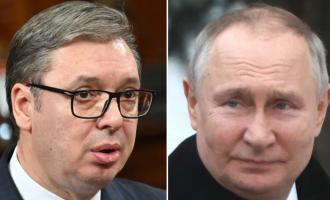Japan and the U.S. on Thursday carried out a surface-to-air drill here on a Japanese island, part of the Nansei Islands, roughly 850 km from Taiwan, in a show of unity that coincided with the 100th anniversary of the Chinese Communist Party.
Forty members of the Ground Self-Defense Force and 30 U.S. Army soldiers gathered under clouds at a hilltop garrison on Amami Oshima, where they deployed truck-mounted launchers for anti-air missiles.
The drill, meant to show the allies' ability to project force on Japan's outlying islands, comes amid heightened tensions in the Taiwan Strait. The U.S. and Japan have been conducting war games in the event of a conflict with China over Taiwan, the Financial Times reports.
The exercise in Amami Oshima -- part of the first island chain stretching from southwestern Japan to Taiwan and beyond -- brought missile defense units to one of Japan's more distant islands for the first time. The drill was intended to simulate defensive maneuvers against hostile aircraft and missiles.
While troops adjusted the equipment -- "Move a few meters," one of them called out in English -- Japanese and American commanders conferred, also in English, huddled around a screen indoors. They monitored radar data that was collected by both countries and relayed via the GSDF camp in the Japanese city of Itami and other command centers in order to prevent troops from aiming at overlapping targets or friendly aircraft.
As part of the drill, the GSDF deployed two midrange anti-air guided missile launchers. The U.S. deployed two Patriot Advanced Capability-3 surface-to-air missile batteries. No live ammunition was launched, but every other step reflected what would happen in a real attack.
The drill was part of the joint Orient Shield exercise by Japanese and U.S. forces, running June 18 to July 11. Three thousand service members participate in various drills across Japan over the three-plus weeks, including a live-fire exercise in Hokkaido.
It took the GSDF three days to transport equipment and people to Amami Oshima from its Aonohara camp, near Kobe in Hyogo Prefecture, by land and ferry. The U.S. forces came from Kadena Air Base in much closer Okinawa.
During the Cold War, when the allies were focused on the Soviet threat, joint drills mainly involved tanks and other ground units in Hokkaido, just a stone's throw from Russia.
But the Asia-Pacific security landscape has shifted, with an increasingly assertive China now the priority. The allies need the ability to respond quickly to an invasion of Taiwan or Japan's Senkaku Islands, which are claimed by China as the Diaoyu. Taiwan is just 170 km from the Senkakus.
Hokkaido is home to large garrisons and training grounds, making it easy to deploy substantial numbers of troops and equipment there regularly. But the Nansei Islands, which include Okinawa, Amami Oshima and the Senkakus, have few large defense facilities, so the ability to bring forces there quickly from across Japan is critical.
"Amami Oshima is a central part of the Nansei Islands, a primary focus in Japan's defense, and is extremely important geopolitically," Gen. Yoshihide Yoshida, chief of staff for the GSDF, told reporters after the drill. "This was a great opportunity for us to showcase the strengthening alliance between Japan and the U.S. to those in the country and abroad."
Brig. Gen. Joel "J.B." Vowell, commander of the U.S. Army Japan, said the Nansei Islands are vulnerable to hostile forces. He said it was important to show that the U.S. and Japan are ready to jointly defend the islands in an emergency.
Brig. Gen. Joel Vowell, commander of the U.S. Army Japan, center, speaks to reporters with Gen. Yoshihide Yoshida, chief of staff for Japan's Ground Self-Defense Forces, at far left. (Photo by Junnosuke Kobara)
Chinese President Xi Jinping said in a speech Thursday that "resolving the Taiwan question and realizing China's complete reunification is a historic mission and an unshakable commitment of the Communist Party of China."
The remark seemingly came in response to a statement by U.S. President Joe Biden and Japanese Prime Minister Yoshihide Suga in April, when the leaders urged "peace and stability in the Taiwan Strait" for the first time in decades.
Thursday's drill also spotlighted new domains in defense. The GSDF camp in Itami, which commanded the drill, practiced responses to cyber and electromagnetic attacks that same day.
Cyber and other nonphysical threats are on the rise, adding to the traditional war domains of land, sea and air. Such attacks on command chains and defense equipment can inflict heavy damage, especially when combined with physical strikes.
Russia used electromagnetic weapons against Ukrainian forces when it annexed Crimea in 2014. The efforts at Itami come as countries like China, Russia and North Korea hone their capabilities in these new domains.















